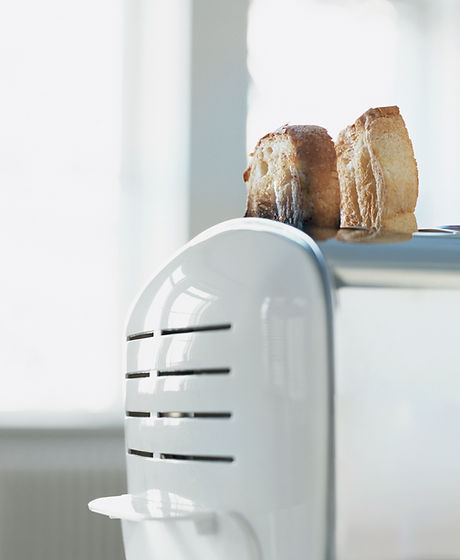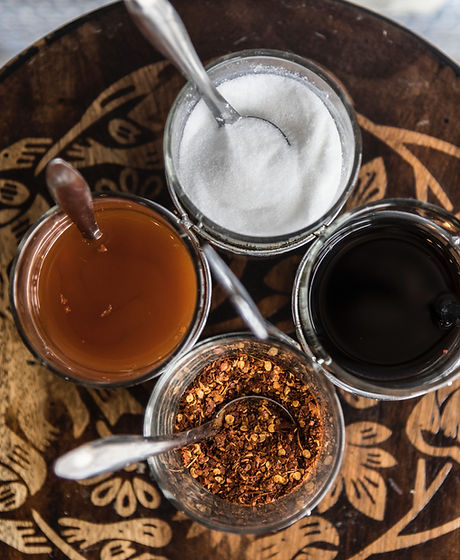
Preventing
Cross-Contamination
What is cross-contamination?
Cross-contamination is considered a process in which food is in contact with a foreign substance that is potentially harmful to an individual's health (1). In the gluten-free diet, exposing gluten-free foods to gluten can occur at any point in the cooking process. If your family does not eat gluten-free, it is important to consider areas of the kitchen that pose a high risk of contamination. Follow the suggestions below to keep your kitchen safe and to minimize cross-contamination as much as possible.

Food Storage
Contamination is most likely to occur in areas where a variety of foods are stored (1). Following a plan to organize your kitchen can minimize the risk of accidental gluten exposure.
-
Store gluten-free foods in a separate cupboard if possible.
-
Keep gluten-free foods on shelves above foods containing gluten if a separate location is not available. This will prevent foods from spilling or leaking on gluten-free products.

Kitchen Sink
-
Check that the sink is clean before filling it with water and soap. The sink may have small pieces of food that should be removed before gluten-free dishes are washed.
-
Wash gluten-free dishes first to prevent gluten exposure in the sink.
-
Use the appropriate cleaning equipment. There should be a designated gluten-free washcloth and drying towel used only to clean gluten-free dishes.
-
Designate a gluten-free sponge.

Microwave
-
Cover gluten-free foods in the microwave to reduce the risk of gluten exposure.
-
Clean the microwave by wiping the inside and outside of the appliance (including handles and buttons) regularly.

Dishwasher
Dishwasher filters can hold particles of food if they aren't cleaned. For most properly working dishwashers, this shouldn't be an issue.
-
Use your dishwasher's self-cleaning option regularly if available.
-
Ensure your dishwasher is working efficiently.
-
Check to make sure dishes are visibly clean when unloading the dishwasher. A small piece of food left on a dish may lead to accidental contamination.

Kitchen Tools
-
Avoid using wooden kitchen tools that aren't designated gluten-free. This includes salad bowls, tongs, spoons, cutting boards, etc. Wood is porous and can "hold" gluten causing cross-contamination (2).
-
Use a set of gluten-free kitchen tools (if possible) when preparing celiac-friendly meals. The gluten-free tools should be washed separately using a gluten-free cloth, stored in a separate location from other dishes, and labelled appropriately.
-
Have a gluten-free cutting board used only for preparing gluten-free meals.

Toaster
-
Avoid placing gluten-free bread in a shared toaster (2). Bits of breadcrumbs are often held in the toaster and easily expose gluten-free bread to contamination.
-
Purchase a separate toaster (if possible) and use it to toast only gluten-free foods. You can also toast your bread on a designated gluten-free pan using butter or oil.

Condiments
-
Have separate condiments that are designated gluten-free to avoid accidental contamination with utensils that may be used to spread on gluten-containing foods. If a condiment comes in a squirt bottle, it can be safely shared if used appropriately.
-
Use a separate butter dish for gluten-free cooking (2).

Kitchen Counter
-
Designate a separate area of the counter top for preparing only gluten-free foods (2).
-
Check that the counter space being used to prepare foods is free of crumbs or dust of flour.
-
Clean the counter top regularly to keep your kitchen safe and gluten-free.

Kitchen Equipment
-
Wash equipment such as pots and pans thoroughly before cooking gluten-free foods (2).
-
Have a separate strainer designated for gluten-free pasta to ensure you are minimizing your risk of contamination.
-
Ensure baking equipment is well scrubbed before use. If possible, consider separate gluten-free baking equipment and use paper muffin liners.
References
1. Bascuñán K, Catalina Vespa M, Araya M. Celiac disease: understanding the gluten-free diet. Eur J Nutr 2017;56:449-459.
2. Canadian Celiac Association. Getting Started on the Gluten-free Diet. https://www.celiac.ca/living-gluten-free/newly-diagnosed/; 2020 [accessed 15.12.2020]



